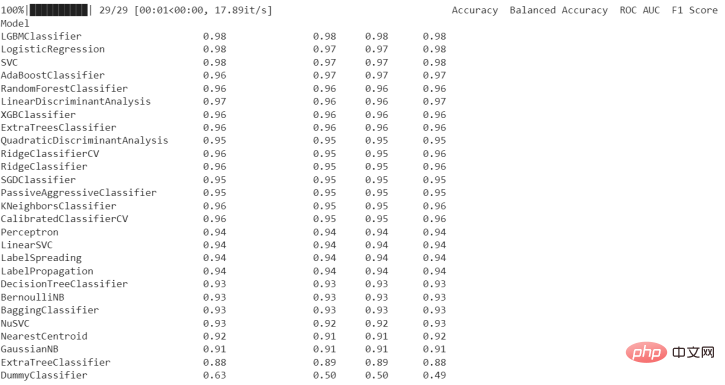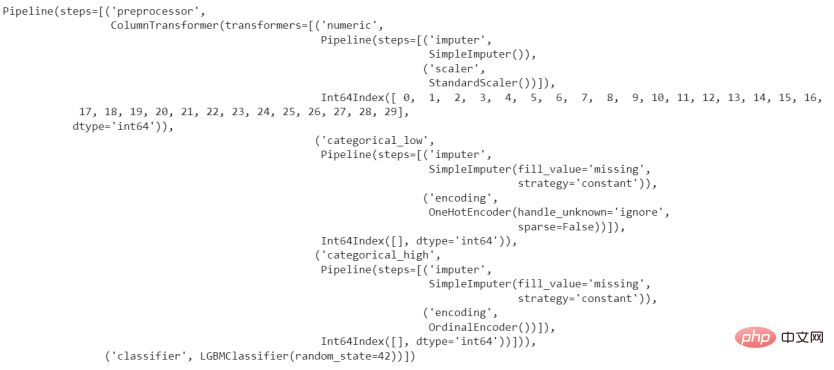LazyPredict: Choose the best ML model for you!
This article discusses using LazyPredict to create a simple ML model. The characteristic of LazyPredict's creation of machine learning models is that it does not require a lot of code and can perform multi-model fitting without modifying parameters, thereby selecting the best performing model among many models.
Summary
This article discusses using LazyPredict to create a simple ML model. The characteristic of LazyPredict's creation of machine learning models is that it does not require a lot of code and can perform multi-model fitting without modifying parameters, thereby selecting the best performing model among many models.

This article includes the following content:
- Introduction
- Installation of LazyPredict module
- In the classification model Implementing LazyPredict in regression models Revolutionize the way machine learning models are developed. By using LazyPredict, a variety of basic models can be created quickly with almost no coding, freeing up time to choose the model that best fits our data.
- The main advantage of LazyPredict is that it can make model selection easier without requiring extensive parameter tuning of the model. LazyPredict provides a fast and efficient way to find and fit the best model to your data.
- Next, let’s explore and learn more about the usage of LazyPredict through this article.
!pip install lazypredict
from sklearn.datasets import load_breast_cancer
from lazypredict.Supervised import LazyClassifier
data = load_breast_cancer()
X = data.data
y= data.target
Copy after login
In order to select the best classifier model, let us now deploy the "LazyClassifier" algorithm. These characteristics and input parameters are suitable for this class.
from sklearn.datasets import load_breast_cancer from lazypredict.Supervised import LazyClassifier data = load_breast_cancer() X = data.data y= data.target
LazyClassifier( verbose=0, ignore_warnings=True, custom_metric=None, predictions=False, random_state=42, classifiers='all', )
from lazypredict.Supervised import LazyClassifier
from sklearn.model_selection import train_test_split
# split the data
X_train, X_test, y_train, y_test = train_test_split(X, y,test_size=0.3,random_state =0)
# build the lazyclassifier
clf = LazyClassifier(verbose=0,ignore_warnings=True, custom_metric=None)
# fit it
models, predictions = clf.fit(X_train, X_test, y_train, y_test)
# print the best models
print(models)
Copy after login
After executing the above code, the following results are obtained:
from lazypredict.Supervised import LazyClassifier from sklearn.model_selection import train_test_split # split the data X_train, X_test, y_train, y_test = train_test_split(X, y,test_size=0.3,random_state =0) # build the lazyclassifier clf = LazyClassifier(verbose=0,ignore_warnings=True, custom_metric=None) # fit it models, predictions = clf.fit(X_train, X_test, y_train, y_test) # print the best models print(models)
model_dictionary = clf.provide_models(X_train,X_test,y_train,y_test)
 Next, set the name of the model to display detailed step information.
Next, set the name of the model to display detailed step information. model_dictionary['LGBMClassifier']

Here we can see that SimpleImputer is used for the entire dataset and then StandardScaler is used for the numeric features. There are no categorical or ordinal features in this dataset, but if there were, OneHotEncoder and OrdinalEncoder would be used respectively. The LGBMClassifier model receives the data after transformation and classification.
LazyClassifier’s internal machine learning model uses the sci-kit-learn toolbox for evaluation and fitting. When the LazyClassifier function is called, it will automatically build and fit various models on our data, including decision trees, random forests, support vector machines, etc. A set of performance metrics you provide, such as precision, recall, or F1 score, are used to evaluate these models. The training set is used for fitting, while the test set is used for evaluation.
After evaluating and fitting the model, LazyClassifier will provide a summary of the evaluation results (as shown in the table above), as well as a list of top models and performance indicators for each model. Since there is no need to manually tune or select models, you can quickly and easily evaluate the performance of many models and choose the one that best fits your data.
 The same job can be done again for a regression model using the "LazyRegressor" function. Let's import a dataset suitable for the regression task (using the Boston dataset).
The same job can be done again for a regression model using the "LazyRegressor" function. Let's import a dataset suitable for the regression task (using the Boston dataset).
Now, let’s use LazyRegressor to fit our data.
from lazypredict.Supervised import LazyRegressor from sklearn import datasets from sklearn.utils import shuffle import numpy as np # load the data boston = datasets.load_boston() X, y = shuffle(boston.data, boston.target, random_state=0) X = X.astype(np.float32) # split the data X_train, X_test, y_train, y_test = train_test_split(X, y,test_size=0.3,random_state =0) # fit the lazy object reg = LazyRegressor(verbose=0, ignore_warnings=False, custom_metric=None) models, predictions = reg.fit(X_train, X_test, y_train, y_test) # print the results in a table print(models)
The code execution results are as follows:
以下是对最佳回归模型的详细描述:
model_dictionary = reg.provide_models(X_train,X_test,y_train,y_test) model_dictionary['ExtraTreesRegressor']

这里可以看到SimpleImputer被用于整个数据集,然后是StandardScaler用于数字特征。这个数据集中没有分类或序数特征,但如果有的话,会分别使用OneHotEncoder和OrdinalEncoder。ExtraTreesRegressor模型接收了转换和归类后的数据。
结论
LazyPredict库对于任何从事机器学习行业的人来说都是一种有用的资源。LazyPredict通过自动创建和评估模型的过程来节省选择模型的时间和精力,这大大提高了模型选择过程的有效性。LazyPredict提供了一种快速而简单的方法来比较几个模型的有效性,并确定哪个模型系列最适合我们的数据和问题,因为它能够同时拟合和评估众多模型。
阅读本文之后希望你现在对LazyPredict库有了直观的了解,这些概念将帮助你建立一些真正有价值的项目。
译者介绍
崔皓,51CTO社区编辑,资深架构师,拥有18年的软件开发和架构经验,10年分布式架构经验。
原文标题:LazyPredict: A Utilitarian Python Library to Shortlist the Best ML Models for a Given Use Case,作者:Sanjay Kumar
The above is the detailed content of LazyPredict: Choose the best ML model for you!. For more information, please follow other related articles on the PHP Chinese website!

Hot AI Tools

Undresser.AI Undress
AI-powered app for creating realistic nude photos

AI Clothes Remover
Online AI tool for removing clothes from photos.

Undress AI Tool
Undress images for free

Clothoff.io
AI clothes remover

Video Face Swap
Swap faces in any video effortlessly with our completely free AI face swap tool!

Hot Article

Hot Tools

Notepad++7.3.1
Easy-to-use and free code editor

SublimeText3 Chinese version
Chinese version, very easy to use

Zend Studio 13.0.1
Powerful PHP integrated development environment

Dreamweaver CS6
Visual web development tools

SublimeText3 Mac version
God-level code editing software (SublimeText3)

Hot Topics
 1386
1386
 52
52
 15 recommended open source free image annotation tools
Mar 28, 2024 pm 01:21 PM
15 recommended open source free image annotation tools
Mar 28, 2024 pm 01:21 PM
Image annotation is the process of associating labels or descriptive information with images to give deeper meaning and explanation to the image content. This process is critical to machine learning, which helps train vision models to more accurately identify individual elements in images. By adding annotations to images, the computer can understand the semantics and context behind the images, thereby improving the ability to understand and analyze the image content. Image annotation has a wide range of applications, covering many fields, such as computer vision, natural language processing, and graph vision models. It has a wide range of applications, such as assisting vehicles in identifying obstacles on the road, and helping in the detection and diagnosis of diseases through medical image recognition. . This article mainly recommends some better open source and free image annotation tools. 1.Makesens
 This article will take you to understand SHAP: model explanation for machine learning
Jun 01, 2024 am 10:58 AM
This article will take you to understand SHAP: model explanation for machine learning
Jun 01, 2024 am 10:58 AM
In the fields of machine learning and data science, model interpretability has always been a focus of researchers and practitioners. With the widespread application of complex models such as deep learning and ensemble methods, understanding the model's decision-making process has become particularly important. Explainable AI|XAI helps build trust and confidence in machine learning models by increasing the transparency of the model. Improving model transparency can be achieved through methods such as the widespread use of multiple complex models, as well as the decision-making processes used to explain the models. These methods include feature importance analysis, model prediction interval estimation, local interpretability algorithms, etc. Feature importance analysis can explain the decision-making process of a model by evaluating the degree of influence of the model on the input features. Model prediction interval estimate
 Identify overfitting and underfitting through learning curves
Apr 29, 2024 pm 06:50 PM
Identify overfitting and underfitting through learning curves
Apr 29, 2024 pm 06:50 PM
This article will introduce how to effectively identify overfitting and underfitting in machine learning models through learning curves. Underfitting and overfitting 1. Overfitting If a model is overtrained on the data so that it learns noise from it, then the model is said to be overfitting. An overfitted model learns every example so perfectly that it will misclassify an unseen/new example. For an overfitted model, we will get a perfect/near-perfect training set score and a terrible validation set/test score. Slightly modified: "Cause of overfitting: Use a complex model to solve a simple problem and extract noise from the data. Because a small data set as a training set may not represent the correct representation of all data." 2. Underfitting Heru
 Transparent! An in-depth analysis of the principles of major machine learning models!
Apr 12, 2024 pm 05:55 PM
Transparent! An in-depth analysis of the principles of major machine learning models!
Apr 12, 2024 pm 05:55 PM
In layman’s terms, a machine learning model is a mathematical function that maps input data to a predicted output. More specifically, a machine learning model is a mathematical function that adjusts model parameters by learning from training data to minimize the error between the predicted output and the true label. There are many models in machine learning, such as logistic regression models, decision tree models, support vector machine models, etc. Each model has its applicable data types and problem types. At the same time, there are many commonalities between different models, or there is a hidden path for model evolution. Taking the connectionist perceptron as an example, by increasing the number of hidden layers of the perceptron, we can transform it into a deep neural network. If a kernel function is added to the perceptron, it can be converted into an SVM. this one
 The evolution of artificial intelligence in space exploration and human settlement engineering
Apr 29, 2024 pm 03:25 PM
The evolution of artificial intelligence in space exploration and human settlement engineering
Apr 29, 2024 pm 03:25 PM
In the 1950s, artificial intelligence (AI) was born. That's when researchers discovered that machines could perform human-like tasks, such as thinking. Later, in the 1960s, the U.S. Department of Defense funded artificial intelligence and established laboratories for further development. Researchers are finding applications for artificial intelligence in many areas, such as space exploration and survival in extreme environments. Space exploration is the study of the universe, which covers the entire universe beyond the earth. Space is classified as an extreme environment because its conditions are different from those on Earth. To survive in space, many factors must be considered and precautions must be taken. Scientists and researchers believe that exploring space and understanding the current state of everything can help understand how the universe works and prepare for potential environmental crises
 Implementing Machine Learning Algorithms in C++: Common Challenges and Solutions
Jun 03, 2024 pm 01:25 PM
Implementing Machine Learning Algorithms in C++: Common Challenges and Solutions
Jun 03, 2024 pm 01:25 PM
Common challenges faced by machine learning algorithms in C++ include memory management, multi-threading, performance optimization, and maintainability. Solutions include using smart pointers, modern threading libraries, SIMD instructions and third-party libraries, as well as following coding style guidelines and using automation tools. Practical cases show how to use the Eigen library to implement linear regression algorithms, effectively manage memory and use high-performance matrix operations.
 Five schools of machine learning you don't know about
Jun 05, 2024 pm 08:51 PM
Five schools of machine learning you don't know about
Jun 05, 2024 pm 08:51 PM
Machine learning is an important branch of artificial intelligence that gives computers the ability to learn from data and improve their capabilities without being explicitly programmed. Machine learning has a wide range of applications in various fields, from image recognition and natural language processing to recommendation systems and fraud detection, and it is changing the way we live. There are many different methods and theories in the field of machine learning, among which the five most influential methods are called the "Five Schools of Machine Learning". The five major schools are the symbolic school, the connectionist school, the evolutionary school, the Bayesian school and the analogy school. 1. Symbolism, also known as symbolism, emphasizes the use of symbols for logical reasoning and expression of knowledge. This school of thought believes that learning is a process of reverse deduction, through existing
 Explainable AI: Explaining complex AI/ML models
Jun 03, 2024 pm 10:08 PM
Explainable AI: Explaining complex AI/ML models
Jun 03, 2024 pm 10:08 PM
Translator | Reviewed by Li Rui | Chonglou Artificial intelligence (AI) and machine learning (ML) models are becoming increasingly complex today, and the output produced by these models is a black box – unable to be explained to stakeholders. Explainable AI (XAI) aims to solve this problem by enabling stakeholders to understand how these models work, ensuring they understand how these models actually make decisions, and ensuring transparency in AI systems, Trust and accountability to address this issue. This article explores various explainable artificial intelligence (XAI) techniques to illustrate their underlying principles. Several reasons why explainable AI is crucial Trust and transparency: For AI systems to be widely accepted and trusted, users need to understand how decisions are made




